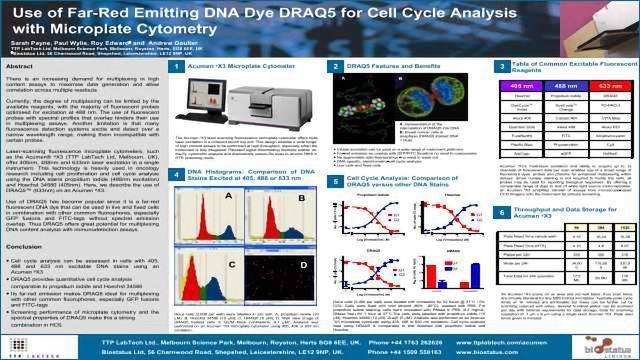Latest Posters

Poster
Development of an Automated siRNA Screening of Host Macrophages Genes Involved in Mycobacterium Tuberculosis Infection
In order to identify host genes required for M. tuberculosis infection and persistence, we developed a phenotypic cell-based assay in both murine and human cells and adapted it for high throughput and high content screening purposes. Knock-down efficiencies above 80% were achieved in “hard-to-Transfect” macrophage cells. Validation of the assay performed with control siRNAs will be discussed.

Poster
Inflammatory Markers in Leg Ulcer Fluid from Chronic Venous Insufficiency
The purpose of our study was to evaluate soluble matrixmetalloproteinases (MMPs) and their inhibitor (TIMP1) associated to leg ulcer wound fluid in comparison with the tissue localized ones. We aimed to develop an easy-to-perform protocol for the quantification of soluble MMPs / TIMP and associate the obtained levels with the disease stage and prognostic.

Poster
Biomarker Discovery Strategy for Trisomy 21 Using iTRAQ and 4800 Plus MALDI TOF/TOF
Plasma proteins serve as good indicators of disease as there are representative proteins from several cellular processes and thus a potential source for biomarker discovery. The large dynamic range of plasma proteins makes the analysis very challenging, as a large number of low abundance proteins are masked by a few high abundance proteins.

Poster
The Silencing of Multidrug Resistance-Associated Protein 5 by siRNA Complexes
The purpose is to study the role of multidrug resistance-associated protein 5, MRP5 in drug metabolism in human retinal pigment epithelium (RPE). RPE forms the outer part of blood-retinal barrier (BRB) which restricts movements of solutes from systemic bloodstream to the neural retina. The efflux protein, MPR5 is expressed in RPE but its functions are mainly unknown. SiRNA will be tested as a tool to clarify the role of MRP5.

Poster
Use of Far-Red Emitting DNA Dye DRAQ5 for Cell Cycle Analysis with Microplate Cytometry
Laser-scanning fluorescence microplate cytometers, such as the Acumen® eX3 offer 405nm, 488nm and 633nm laser excitation in a single instrument. This technology is heavily used in oncology research including cell proliferation and cell cycle analysis using the DNA stains propidium iodide (488nm excitation) and Hoechst 34580 (405nm). Here, we describe the use of DRAQ5™ (633nm) on an Acumen eX3.

Poster
Proteomic Approach to Identify Stage Specific Biomarkers in Streptozotocin Induced Diabetic Nephropathy
The presence of albumin in the urine of healthy subjects presents a stumbling block in diagnostics putting a question mark on the validity of albumin test for the detection of diabetic nephropathy. Therefore there arises a dire need to hunt for the proteins in the pertinent bio- fluids which can serve as biomarkers.

Poster
Antibody Array-Based Analysis of Expression Levels in Protein Mixtures Extracted from Formalin-Fixed Paraffin-Embedded (FFPE) Material using ULS Labeling
Protein was extracted from 7-year old FFPE samples of B-cell lymphoma and mamma carcinoma, followed by ULS labeling. Samples were used for single or two color assays using a custom-made antibody array. We observed differential expression levels for several captured analytes. In B-cell lymphoma, expected high levels of IgM were detected, while high levels of CA19-9, a putative marker, were found for the breast cancer tissue.

Poster
Whole Body Endogenous Nitric Oxide Production in Patients with Decompensated Liver Disease
Increased nitric oxide (NO) production has been implicated in the pathogenesis of the hyperdynamic circulation found in patients with advanced liver disease. There were no differences between patients with liver disease and controls with regard whole body NO production. Our results, in a well characterised set of patients, argue against greater basal NOS-dependent whole body NO production in patients with decompensated liver disease.

Poster
MS-Xelerator™: Advanced Algorithms for LC/MS Data Processing Applied to Biomarker Discovery, Differential Analysis and Quantitative Proteomics
LC-MS based proteomic experiments are used to compare complex biological samples across multiple conditions. Fast, powerful computational tools are needed to explore and detect differences in the areas of Expression Proteomics and Biomarker Discovery. In general, specialized steps are necessary to solve these difficult problems (binning, alignment & normalization, peak picking, relative quantitation, etc.). MS-Xelerator is a collection of software tools dedicated to all of the above tasks.

Poster
Caveolin-1 Expression as a Possible Biomarker in Pancreatic Cancer Diagnosis
Caveolin1 (Cav-1) function either as a tumor supressor or as a promoter of metastasis. Overexpresion of cav-1 was correlated with: tumoral grading, proliferration markers (Ki67, p53), serum tumor markers (CEA, CA19.9) and angiogenic markers (VEGF, bFGF).
Advertisement

